|
ROBOMOTES: ROBOTS IN SMALL PACKAGES—
Tiny, two-wheeled and wireless, RoboMotes are designed to create sensor networks
that move and reconfigure themselves to adapt to new situations. Developed at
the University of Southern California's Robotic Embedded Systems Lab, the golf-ball-sized
RoboMotes are built on the Mote platform that is becoming popular in the sensor
network community. Each RoboMote includes a wireless network interface (the
'Mote'), two controllable wheels with odometers; a solar cell for
'always-on' power; a compass for direction; and bump and infrared
sensors for obstacle avoidance. Because of their small size and low cost, RoboMotes
make it possible for campus labs to experiment with larger dynamic sensor networks.
RoboMote Project: www-robotics.usc.edu/projects/robomote
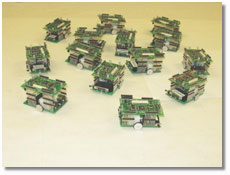 The
RoboMote: A platform for research in robotic sensor networks. The
RoboMote: A platform for research in robotic sensor networks.
Credit: USC Robotic Embedded Systems Lab (PI: Prof. Gaurav S. Sukhatme)
Select image for larger version
(Size: 278KB)
FINGERNAIL SENSORS FOR A LIGHT TOUCH—Repetitive
strain injuries are one of the nation's most common occupational health problems,
costing businesses $2.8 billion annually according to the 2003 Liberty Mutual
Workplace Safety Index. Many repetitive strain injuries stem from the use of
conventional computer keyboards and mice. Researchers led by Harry Asada at
MIT have developed fingernail sensors that read the subtle changes in blood
flow under the nail to detect the press of a fingertip even lightly against
a surface and the bending angle of the fingertip. And because the sensors mount
on the fingernail, they don't interfere with the finger's sense of touch. The
sensors might replace computer keyboards and mice for persons with repetitive
strain injuries or with limited hand mobility.
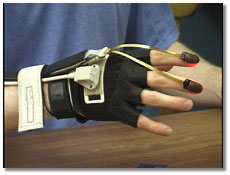 Fingernail
sensors unobtrusively measure the state of the human fingertip. The sensors
optically measure the pattern of blood volume in the capillaries beneath the
fingernail, which depends predictably on the posture of the finger as well as
the forces of the fingertip pressing against a surface (including two dimensions
of shear force). Fingernail
sensors unobtrusively measure the state of the human fingertip. The sensors
optically measure the pattern of blood volume in the capillaries beneath the
fingernail, which depends predictably on the posture of the finger as well as
the forces of the fingertip pressing against a surface (including two dimensions
of shear force).
Credit: Stephen Mascaro, MIT
Select image for larger version
(Size: 48KB)
SCOUTING OUT NEW TERRITORY—A
robot's design typically depends on the task it was built to accomplish, and
robot teams are often composed of robots of similar form. Nikos Papanikolopoulos
and colleagues at the University of Minnesota Center for Distributed Robotics
are conducting research into robot teams that have the added complexity of two
or more different types of robots, each with different sensing and control capabilities.
The COTS Scout, for example, is a remotely controlled robot, about the size
of a coffee mug, with a black-and-white video camera. The MegaScout is a 15-inch
long robot, with color cameras and other sensors designed to provide command-and-control
support for a Scout team. The ultimate objective is for the individual robots
to combine forces and accomplish certain tasks better than any single robot.
Center for Distributed Robotics: distrob.cs.umn.edu
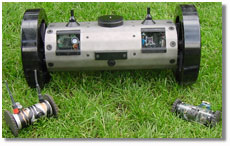 The
five-inch wide COTSScout (left), 15-inch MegaScout (center) and four-inch Scout
(right) from the University of Minnesota Center for Distributed Robotics. The
five-inch wide COTSScout (left), 15-inch MegaScout (center) and four-inch Scout
(right) from the University of Minnesota Center for Distributed Robotics.
Credit: University of Minnesota Center for Distributed Robotics
Select image for larger version
(Size: 238KB)
DIGITAL CLAY FOR COMPUTER TOUCH AND FEEL—It
often feels like people have to mold themselves to the computer rather than
the other way around. Wayne Book and colleagues at Georgia Tech want to change
that. They are developing a technology called 'digital clay,' in which
computer users would interact with virtual worlds or objects much as they would
shape modeling clay. In some cases, the digital-clay surface might even push
back—for example, if the virtual object the user is molding resists being
re-shaped. The potential applications for digital clay range from designing
3-D objects and navigating 3-D virtual worlds to providing an alternative interface
for visually challenged users.
Digital Clay Project: www.me.gatech.edu/digitalclayproject
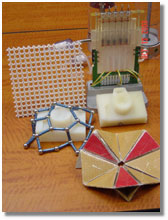 Digital
Clay combines the intuitive sculpting of natural clay with intelligent, programmable
haptic feedback to the sculptor. The photograph shows two implementation concepts:
the 'formable crust' and the 'bed of nails.' The formable
crust uses a new implementation of the ball joint (foreground) that, when combined
as illustrated (on the middle left), enables the shell to conform to arbitrary
shapes. As implemented in stereolithography (upper left), it can be scaled to
fine resolution. The bed of nails concept and its control is studied using an
expandible 5x1 array of cells (upper right). With MEMS technology under development
for valves and actuators, this concept will be scalable to higher resolution,
similar to the surrogate bed of nails model of a camera (middle right). This
stereolithography model was created for user studies of the needed resolution
and optimal surface. Digital
Clay combines the intuitive sculpting of natural clay with intelligent, programmable
haptic feedback to the sculptor. The photograph shows two implementation concepts:
the 'formable crust' and the 'bed of nails.' The formable
crust uses a new implementation of the ball joint (foreground) that, when combined
as illustrated (on the middle left), enables the shell to conform to arbitrary
shapes. As implemented in stereolithography (upper left), it can be scaled to
fine resolution. The bed of nails concept and its control is studied using an
expandible 5x1 array of cells (upper right). With MEMS technology under development
for valves and actuators, this concept will be scalable to higher resolution,
similar to the surrogate bed of nails model of a camera (middle right). This
stereolithography model was created for user studies of the needed resolution
and optimal surface.
Credit: Georgia Tech Digital Clay Team: M. Allen, W. Book, I. Eber-Uphoff, A.
Glezer, J. Goldthwaite, D. Rosen, J. Rossignac, C. Shaw and their colleagues
and students
Select image for larger version
(Size: 439KB)
LONG-DISTANCE ROBOT CONTROL AND FEEDBACK—Remote
operation of scientific instruments across the Internet works best if the instruments,
such as telescopes or electron microscopes, have well-defined movement and behavior.
However, controlling a mobile robot with a manipulator arm—perhaps on
another continent—is not so straightforward when the operator can't feel
the robot's movement, position or grasp, not to mention the surrounding environment.
Ning Xi and colleagues at the Michigan State University Robots and Automation
Lab are creating a sensory link to help humans feel connected to a robot in
a remote environment. This sensory connection—in the form of visual, audio,
tactile and even temperature feedback—must overcome numerous technical
networking issues, such as the unpredictable delay in signals traversing the
Internet.
Michigan State Robots and Automation Lab: www.egr.msu.edu/ralab
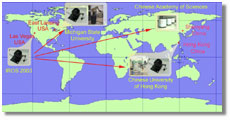 Ning
Xi at the Michigan State University Robots and Automation Lab and collaborators
have designed a system so that people in different parts of the world can control
mobile robots and receive 'supermedia' feedback at remote locations
via the Internet. Ning
Xi at the Michigan State University Robots and Automation Lab and collaborators
have designed a system so that people in different parts of the world can control
mobile robots and receive 'supermedia' feedback at remote locations
via the Internet.
Credit: Michigan State University, Chinese University of Hong Kong, Chinese
Academy of Sciences
Select image for larger version
(Size: 110KB)
IMPROVED ROBOT VISION SAVES BADLY EXPOSED PHOTOGRAPHS—Don't
throw away those badly exposed digital photographs just yet. Shadow Illuminator
can fix them in a snap. Shadow Illuminator technology, by Vladimir Brajovic
at Carnegie Mellon University, results from Brajovic's NSF-funded computer vision
research project. Unlike humans, robots are often confused when the lighting
conditions change. Shadow Illuminator makes robot vision more reliable despite
bad lighting by mathematically mimicking processes that take place in the human
eye. Shadow Illuminator 'looks' at the scene content, estimates the
illumination conditions and digitally adds light to dark areas. The shadows
are brightened, and details in the shadows are enhanced as if they were properly
lighted. At the free Shadow Illuminator Web site, you can upload your picture
and instantly see details you didn't know were there.
Shadow Illuminator: www.shadowilluminator.org
STRETCHABLE CIRCUITS FOR ROBOTIC SENSOR
SKIN—Human skin protects the body from the outside world, bends
and stretches to let us move around and has nerve endings for our sense of touch.
But robot 'skins' thus far have not been able to handle all three
functions at the same time because typical electrical circuits don't like to
be stretched. Sigurd Wagner and Stephanie Lacour at Princeton University have
now changed that. They have created the first stretchable metal film interconnects
for elastic integrated circuits. Consisting of 25-nanometer-thick stripes of
gold on a silicone membrane, these interconnects can be stretched by at least
15 percent and bounce back, conducting electricity all the while. Some samples
have been stretched to twice their original length and remained conductive.
But so far, they don't know why it works. The elastic circuits represent a new
material for robotic skin that can stretch, wrinkle or shrink while transmitting
data to embedded sensors.
Princeton Macroelectronics Group: www.ee.princeton.edu/~asg
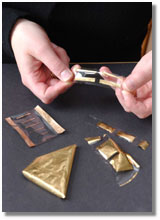 Samples
of robotic sensor 'skin' with stretchable gold electrodes deposited
onto compliant silicone elastomer membranes. Samples
of robotic sensor 'skin' with stretchable gold electrodes deposited
onto compliant silicone elastomer membranes.
Credit: S.P. Lacour, S. Wagner, Princeton University
Select image for larger version
(Size: 155KB)
|



